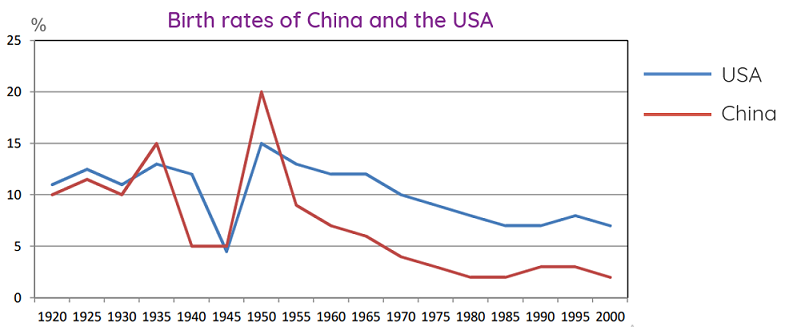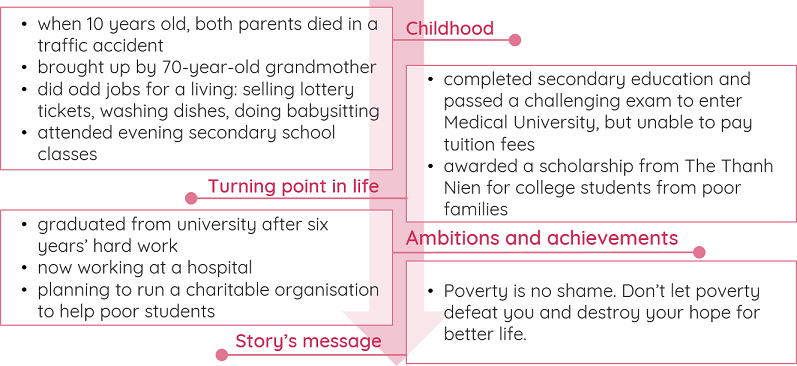Hãy nhập câu hỏi của bạn vào đây, nếu là tài khoản VIP, bạn sẽ được ưu tiên trả lời.

Em viết phần intro nha:
The chart above decsribes how the birth rates of 2 countries namely China, USA changed in 80 years which started from 1920
Answer:
The line graph compares the birth rates in China and the US and how these rates changed from 1920 to 2000.
Overall, there was a general decline in fertility of both nations throughout the time surveyed. However, the US’s birth rates almost was higher than that of China over the whole period.
American saw a significant fluctuation in the birth rates between 1920 to 1935, but it always remained over 10%. However, in the following decade, the fertility of the US decreased sharply to under 5 %. From 1945 to 1950, there was a rapidly increased in American’s birth rates, at 15%, reaching the highest point of it’s own during the whole period. From that on, the fertility of the US fell gradually to 7% in 2000.
During the 80-year period, the birth rates in China changed more significantly than in the US. It fell down to 5% in the year 1940, then reaching a peak of whole line graph in 1950, at 20%. Over the remainder of the period, China saw a sharply drop in the birth rates to only about 2% until 2000.

Gửi bạn nhé
Dear (người nhận),
I hope this letter finds you in good health and high spirits. I wanted to take this opportunity to tell you about the family rules that we have in my home. Family rules are important as they help create a harmonious and respectful environment for everyone.
Firstly, we believe in open communication. We encourage everyone in the family to express their thoughts and feelings freely, while also listening to others with respect and empathy. This helps us understand each other better and resolve conflicts peacefully.
Secondly, we have a rule of mutual respect. We treat each other with kindness and consideration, regardless of age or relationship. We believe that everyone's opinions and choices should be valued, and we strive to support and encourage each other in our endeavors.
Furthermore, we have a rule of shared responsibilities. We believe that everyone in the family should contribute to the household chores and responsibilities. This fosters a sense of teamwork and teaches us the importance of taking care of our living space.
Lastly, we have a rule of quality time. We prioritize spending time together as a family, whether it's through shared meals, outings, or game nights. This helps us strengthen our bond and create lasting memories.
These family rules have helped us maintain a loving and respectful environment at home. I would love to hear about your family rules and how they contribute to your household dynamics.
Take care and write back soon!
Warm regards,
Người nhận

1 What does he likes doing in his free time
2 Who does he often travel to African countries with
3 Which country is one of the richest countries in this continent
4 What do they hate
5 sai sai

It's believed that cultural identity helps us identify ourselves as part of a culture.
This can be shown through the language we use to communicate, the food we often eat, the national clothes we wear on special occasions or festivals and cultural praces.
Among these, I think food and culinary traditions are the most important cultural identifiers.
On an individual level, there is a connection between food and each person's family ties.
We grow up eating the food cooked by our mother or other members in our family, so food becomes closely connected to our family traditions.
Many of us associate food from our childhood with warm feelings and good memories and it reminds us of our families and holds a special and personal value for us.
Food from our family often becomes the comfort food we seek when we miss our family or feel stressed.
I still remember a memorable moment when I was a kid.
I could not eat rice because I had a toothache.
My mother cooked soup and brought it to bed for me.
The flavor of the soup became something very familiar to me.
Now, whenever I feel tired or stressed, I remember the soup my mom used to make for me and I crave that soup.
On a larger scale, food is an important part of national culture.
It helps tell where each of us is from.
Each country has its own national cuisine.
For example, Chinese food mainly has sweet and spicy flavor with a special focus on red color decoration.
Traditional cuisine is passed down from one generation to the next and acts as a prominent expression of cultural identity.
Immigrants bring the food of their countries with them wherever they go and cooking traditional food is a way of preserving their culture when they move to new places.
In conclusion, food connects people to their family and nation, so it is a good reflection of a person's culture identity.
Some people believe cultural identity is how we identify ourselves as part of a culture.This can simply be done through the language we use, the food we often have, or the clothing we often wear on special occasions. In my opinion, festivals and cultural praces celebrated and preserved years after years are the most important cultural identifiers.
Through festivals, we want to express our unity as well as cultural identifier. Originally, festivals are special occasions when people at a parular place stop working in order to celebrate parties or events. They are often connected with religious beliefs of a specific group of people to thank God sand ancestors for good harvests, fortune, and happiness.
Along with festivals, cultural praces are unique ways of expressing who we are and what country or culture we belong to. These are traditionally considered the right things to do in a community. For example, Vietnamese people usually go to pagodas on first days of New Year to pray for good health and happiness. Although we are now in modern time, these traditions are well preserved respectably as a cultural stereotype.
As people all over the world become closer and closer, we share our festivals and cultural praces - the most important features. We organise international festivals and take part in various kinds of cultural events in other countries. This is always the meaningful way of identifying, sharing and preserving cultures.

Poverty is no shame
My parents died in a traffic accident when I was ten years old, so I grew up with my grandmother who was too old and weak to work. I had to leave school and did odd jobs to earn a living: selling lottery kets, washing dishes and doing babysitting. When I was 15, my grandma encouraged me to attend evening classes, so I could improve my literacy and job prospects.
After lots of hardship and effort, I completed secondary education and passed a challenging exam to enter Medical University, which is the dream of many students. However, I could not pay the tuition fees and had to reject the offer. The door to a new life was closed before me. I was completely disappointed and saw only gloomy days ahead.Then something incredible happened: I was awarded a scholarship from The Thanh Nien for college students from poor families. This was really a turning point in my life because I could start my university studies and hope for a better future.
Six years of hard work at the university and of trying to live on a very tight budget came to an end at last. Now I am working as a doctor at a hospital, but I will never forget those difficult days. I am planning to set up and run a charitable organisation to help poor students, as a way to acknowledge other people for supporting me.
I've told my own story hoping to encourage other people me to overcome hard times. Don't let poverty defeat you and destroy your hopes for a better future. This is my motto.

1. I____will give______you a lift to work tommorow if you like.
2. a study into children's television [view]___viewing___ habits reveals that children whose parents have a high level of [educate]_education___ tend to watch less television than children from less educated family. [back]_backgrounds____. The report also suggests that a high rate of TV watching among children in poorer [suburb]___suburbant___ areas and in the provinces, compared to those living in large urban centres, is often due to [poor]___poverty___ and a lack of other kinds of [entertain]___entertainment__ in the area. Disco, cinema, theater and sports [active]__activities__ offer children in urban centres a wider range of pastimes, which leads to far [few]___fewer___ hours being spent in front of the box. [commerce]__commercials___, comedies and adventure films are children's [favour]_favorite__ programmes, while twenty percent of children said they prefered [violence]___violent____ films anf thrillers.

Hàng triệu sinh viên nói tiếng Anh không tham dự lớp học ở Cameroon
Hàng triệu học sinh không tham dự các lớp học ở các vùng nói tiếng Anh của Cameroon khi trường học bắt đầu gần đây. Các trường học mở cửa sau khi chính phủ phát hành nhiều nhà lãnh đạo bị bắt giam trong các khu vực nói tiếng Anh của Cameroon. Các cuộc biểu tình được kêu gọi để hướng sự chú ý vào những gì mà một số người coi là ảnh hưởng mạnh mẽ của tiếng Pháp trong nước. Cameroon có hai ngôn ngữ chính thức: tiếng Pháp và tiếng Anh. Nhiều người nói tiếng Anh tin rằng họ bị phân biệt đối xử bởi những người nói tiếng Pháp.
Các trường học đã bị đóng cửa ở vùng tây bắc và tây nam nói tiếng Anh của Cameroon kể từ tháng 11. Đó là khi các luật sư và giáo viên kêu gọi đình công để ngăn chặn những gì họ tin là việc sử dụng quá mức tiếng Pháp. Sau khi các nhà lãnh đạo đình công bị bắt, các nhóm áp lực yêu cầu họ phải ra đi ngay trước kỳ học mới. Tuần trước, 55 trong số 75 người biểu tình đã được thả ra, trong khi những cáo buộc chống lại họ đã bị loại.
Tick nha

1.After a decade of economic liberzation,VN has been a dramatic rise in living______ in urban areas.
A.surface B.standards C.levels D.backgrounds
2.The______effect of the new policy is that the famer is now working for himself and not for the stae sake
A.legal B.common C.all D.overall

